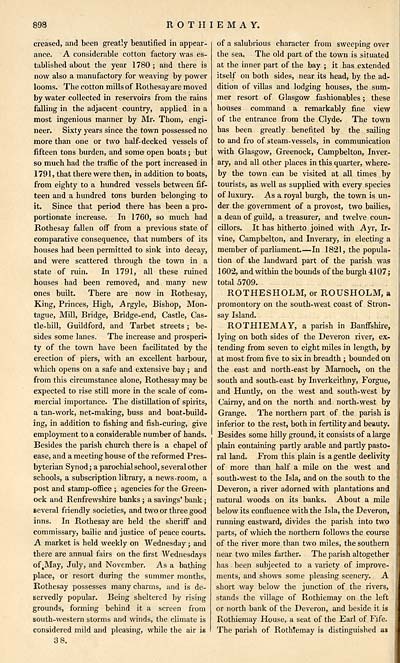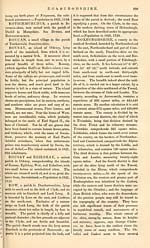Gazetteer of Scotland > Volume 2
(418) Page 898
Download files
Complete book:
Individual page:
Thumbnail gallery: Grid view | List view

898
R O T II I E M A Y.
creased, and been greatly beautified in appear-
ance. A considerable cotton factory was es-
tablished about the year 1780 ; and there is
now also a manufactory for weaving by power
looms. The cotton mills of Rothesay are moved
by water collected in reservoirs from the rains
falling in the adjacent country, applied in a
most ingenious manner by Mr. Thorn, engi-
neer. Sixty years since the town possessed no
more than one or two half-decked vessels of
fifteen tons burden, and some open boats ; but
so much had the traffic of the port increased in
1 79 1 , that there were then, in addition to boats,
from eighty to a hundred vessels between fif-
teen and a hundred tons burden belonging to
it. Since that period there has been a pro-
portionate increase. In 1760, so much had
Rothesay fallen off from a previous state of
comparative consequence, that numbers of its
houses had been permitted to sink into decay,
and were scattered through the town in a
state of ruin. In 1791, all these ruined
houses had been removed, and many new
ones built. There are now in Rothesay,
King, Princes, High, .Argyle, Bishop, Mon-
tague, Mill, Bridge, Bridge-end, Castle, Cas-
tle-hill, Guildford, and Tarbet streets ; be-
sides some lanes. The increase and prosperi-
ty of the town have been facilitated by the
erection of piers, with an excellent harbour,
which opens on a safe and extensive bay ; and
from this circumstance alone, Rothesay may be
expected to rise still more in the scale of com-
mercial importance. The distillation of spirits,
a tan-work, net-making, buss and boat-build-
ing, in addition to fishing and fish-curing, give
employment to a considerable number of hands.
Besides the parish church there is a chapel of
ease, and a meeting house of the reformed Pres-
byterian Synod; a parochial school, several other
schools, a subscription library, a news-room, a
post and stamp-office ; agencies for the Green-
ock and Renfrewshire banks ; a savings' bank ;
several friendly societies, and two or three good
inns. In Rothesay are held the sheriff and
commissary, bailie and justice of peace courts.
A market is held weekly on Wednesday ; and
there are annual fairs on the first Wednesdays
of 4 May, July, and November. As a bathing
place, or resort during the summer months,
Rothesay possesses many charms, and is de-
servedly popular. Being sheltered by rising
grounds, forming behind it a screen from
south-western storms and winds, the elimate is
considered mild and pleasing, while the air is
3 8.
of a salubrious character from sweeping over
the sea. The old part of the town is situated
at the inner part of the bay ; it has extended
itself on both sides, near its head, by the ad-
dition of villas and lodging houses, the sum-
mer resort of Glasgow fashionables ; these
houses command a remarkably fine view
of the entrance from the Clyde. The town
has been greatly benefited by the sailing
to and fro of steam-vessels, in communication
with Glasgow, Greenock, Campbelton, Inver-
ary, and all other places in this quarter, where-
by the town can be visited at all times by
tourists, as well as supplied with every species
of luxury. As a royal burgh, the town is un-
der the government of a provost, two bailies,
a dean of guild, a treasurer, and twelve coun-
cillors. It has hitherto joined with Ayr, Ir-
vine, Campbelton, and Inverary, in electing a
member of parliament. — In 1821, the popula-
tion of the landward part of the parish was
1602, and within the bounds of the burgh 4107 ;
total 5709.
ROTHESHOLM, or ROUSHOLM, a
promontory on the south-west coast of Stron-
say Island.
ROTHIEMAY, a parish in Banffshire,
lying on both sides of the Deveron river, ex-
tending from seven to eight miles in length, by
at most from five to six in breadth ; bounded on
the east and north-east by Marnoch, on the
south and south-east by Inverkeithny, Forgue,
and Huntly, on the west and south-west by
Cairny, and on the north and north-west by
Grange. The northern part of the parish is
inferior to the rest, both in fertility and beauty.
Besides some hilly ground, it consists of a large
plain containing partly arable and partly pasto-
ral land. From this plain is a gentle deelivity
of more than half a mile on the west and
south-west to the Isla, and on the south to the
Deveron, a river adorned with plantations and
natural woods on its banks. About a mile
below its confluence with the Isla, the Deveron,
running eastward, divides the parish into two
parts, of which the northern follows the course
of the river more than two miles, the southern
near two miles farther. The parish altogether
has been subjected to a variety of improve-
ments, and shows some pleasing scenery. A
short way below the junction of the rivers,
stands the village of Rothiemay on the left
or north bank of the Deveron, and beside it is
Rothiemay House, a seat of the Earl of Fife.
The parish of Rothiemay is distinguished as
R O T II I E M A Y.
creased, and been greatly beautified in appear-
ance. A considerable cotton factory was es-
tablished about the year 1780 ; and there is
now also a manufactory for weaving by power
looms. The cotton mills of Rothesay are moved
by water collected in reservoirs from the rains
falling in the adjacent country, applied in a
most ingenious manner by Mr. Thorn, engi-
neer. Sixty years since the town possessed no
more than one or two half-decked vessels of
fifteen tons burden, and some open boats ; but
so much had the traffic of the port increased in
1 79 1 , that there were then, in addition to boats,
from eighty to a hundred vessels between fif-
teen and a hundred tons burden belonging to
it. Since that period there has been a pro-
portionate increase. In 1760, so much had
Rothesay fallen off from a previous state of
comparative consequence, that numbers of its
houses had been permitted to sink into decay,
and were scattered through the town in a
state of ruin. In 1791, all these ruined
houses had been removed, and many new
ones built. There are now in Rothesay,
King, Princes, High, .Argyle, Bishop, Mon-
tague, Mill, Bridge, Bridge-end, Castle, Cas-
tle-hill, Guildford, and Tarbet streets ; be-
sides some lanes. The increase and prosperi-
ty of the town have been facilitated by the
erection of piers, with an excellent harbour,
which opens on a safe and extensive bay ; and
from this circumstance alone, Rothesay may be
expected to rise still more in the scale of com-
mercial importance. The distillation of spirits,
a tan-work, net-making, buss and boat-build-
ing, in addition to fishing and fish-curing, give
employment to a considerable number of hands.
Besides the parish church there is a chapel of
ease, and a meeting house of the reformed Pres-
byterian Synod; a parochial school, several other
schools, a subscription library, a news-room, a
post and stamp-office ; agencies for the Green-
ock and Renfrewshire banks ; a savings' bank ;
several friendly societies, and two or three good
inns. In Rothesay are held the sheriff and
commissary, bailie and justice of peace courts.
A market is held weekly on Wednesday ; and
there are annual fairs on the first Wednesdays
of 4 May, July, and November. As a bathing
place, or resort during the summer months,
Rothesay possesses many charms, and is de-
servedly popular. Being sheltered by rising
grounds, forming behind it a screen from
south-western storms and winds, the elimate is
considered mild and pleasing, while the air is
3 8.
of a salubrious character from sweeping over
the sea. The old part of the town is situated
at the inner part of the bay ; it has extended
itself on both sides, near its head, by the ad-
dition of villas and lodging houses, the sum-
mer resort of Glasgow fashionables ; these
houses command a remarkably fine view
of the entrance from the Clyde. The town
has been greatly benefited by the sailing
to and fro of steam-vessels, in communication
with Glasgow, Greenock, Campbelton, Inver-
ary, and all other places in this quarter, where-
by the town can be visited at all times by
tourists, as well as supplied with every species
of luxury. As a royal burgh, the town is un-
der the government of a provost, two bailies,
a dean of guild, a treasurer, and twelve coun-
cillors. It has hitherto joined with Ayr, Ir-
vine, Campbelton, and Inverary, in electing a
member of parliament. — In 1821, the popula-
tion of the landward part of the parish was
1602, and within the bounds of the burgh 4107 ;
total 5709.
ROTHESHOLM, or ROUSHOLM, a
promontory on the south-west coast of Stron-
say Island.
ROTHIEMAY, a parish in Banffshire,
lying on both sides of the Deveron river, ex-
tending from seven to eight miles in length, by
at most from five to six in breadth ; bounded on
the east and north-east by Marnoch, on the
south and south-east by Inverkeithny, Forgue,
and Huntly, on the west and south-west by
Cairny, and on the north and north-west by
Grange. The northern part of the parish is
inferior to the rest, both in fertility and beauty.
Besides some hilly ground, it consists of a large
plain containing partly arable and partly pasto-
ral land. From this plain is a gentle deelivity
of more than half a mile on the west and
south-west to the Isla, and on the south to the
Deveron, a river adorned with plantations and
natural woods on its banks. About a mile
below its confluence with the Isla, the Deveron,
running eastward, divides the parish into two
parts, of which the northern follows the course
of the river more than two miles, the southern
near two miles farther. The parish altogether
has been subjected to a variety of improve-
ments, and shows some pleasing scenery. A
short way below the junction of the rivers,
stands the village of Rothiemay on the left
or north bank of the Deveron, and beside it is
Rothiemay House, a seat of the Earl of Fife.
The parish of Rothiemay is distinguished as
Set display mode to: Large image | Transcription
Images and transcriptions on this page, including medium image downloads, may be used under the Creative Commons Attribution 4.0 International Licence unless otherwise stated. ![]()
| Gazetteers of Scotland, 1803-1901 > Gazetteer of Scotland > Volume 2 > (418) Page 898 |
|---|
| Permanent URL | https://digital.nls.uk/97435838 |
|---|
| Description | Volume II: Glenbanchor to Zetland. |
|---|---|
| Attribution and copyright: |
|
| Description | By Robert Chambers and William Chambers. Glasgow: Blackie & Son, 1838. 2 volumes. |
|---|---|
| Shelfmark | NF.1461.g.7 |
| Additional NLS resources: | |

